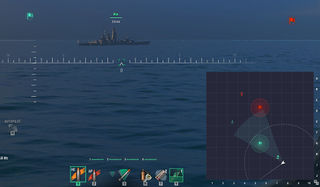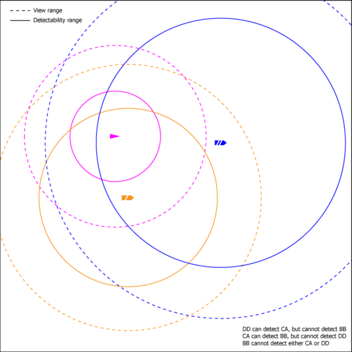偵測距離及迷彩(戰艦世界)
A ship is spotted when another enemy ship or aircraft gets close enough to detect it. This mainly involves two sets of values.
The first set of values is Detection range, which is divided into two categories
- Surface Detectability Range: This is the range at which a ship will be detected by an enemy ship. A Line of Sight (LoS) is required between the spotting ship and the ship being spotted. A ship will not be spotted if there are no enemy ships within this range.
- Air Detectability Range: This is the range at which a ship will be detected by an enemy aircraft. This is usually shorter than the surface detectablity range. Unlike surface detection, catapult launched aircraft can spot enemy ships within 4 km of itself regardless of LoS, beyond that range they need LoS to the ship. Carrier based aircraft are not restricted by LoS at all when detecting enemy ships.
The second set of values is View range, which is also doubles as a ship's render range. It is indicated by the outer limit of the grey cone on the player's minimap in battle. Any ship outside of this range can not be detected by the player, while any allied ships and spotted enemy ships outside of it will not be drawn on the player's screen but will be displayed on the player's minimap as outlined icons. In general, the taller the ship the higher its view range will be. Therefore battleships tend to have very long view ranges (in excess of over 20 km), while destroyers usually have shorter view ranges than other ship classes.
Aircraft carriers have unlimited view range, while aircraft (both catapult launched and carrier based) have a view range of 11 km. In most cases, view range has little impact on ship to ship detection, because it is usually far higher than the detectability range of the ships being spotted. The only time view range has any appreciable effect on ship to ship detection is when the spotting ship has a lower view range than the target's detectability range, such as a destroyer attempting to spot certain battleships. In these cases, the target is spotted not at its detectability range but at the moment it enters the view range of the spotting ship.
In the diagram to the right, assuming all ships are enemies to one another, the destroyer (pink) can detect the cruiser (orange) as the cruiser is within the destroyer's view range (pink dashed line) and the distance between the two ships is smaller than than the cruiser's detectability range (orange line). However, the destroyer can not detect the battleship (blue) even though the distance between them is smaller than the battleship's detectability range (blue line) because the battleship is outside of the destroyer's view range (pink dashed line).
The cruiser on the other hand can detect the battleship, as it is within the cruiser's view range and the distance between them is smaller than the battleship's detectability range, however the cruiser can not detect the destroyer even though it is within the cruiser's view range because the distance between them is larger than the DD's detectability range.
The battleship can not detect either the destroyer or cruiser even though the battleship's view range encompasses both of them because their distance to the battleship is larger than their respective detectability range.
If the destroyer and the battleship is on the same team while the cruiser is on the opposing team, the destroyer will spot the cruiser for the battleship and it will appear as a solid icon on the battleship's minimap and be rendered in its main view. If the destroyer and the cruiser is on the same team while the battleship is on the opposing team, the cruiser will spot the battleship for the destroyer but it will only appear as an outline in the destroyer's minimap and not rendered in its main view.
There are a few factors that can affect spotting:
- Firing main guns. This greatly increases a ship's detectability range for a duration of 20 seconds, allowing it to be spotted at a distance higher than the ship's base detectability range. In general, the bigger caliber of the main guns the bigger the increase will be. The value increased is different for both surface and air detection. As of Patch 0.5.9.0, a ship that is not spotted after firing will not suffer the 20 second camouflage penalty.
The detection formula is as follows: [caliber in mm] x 3 x 10 for visibility from ships [caliber in mm] x 2 x 10 for visibility from airplanes e.g. firing 203mm rifles will increase visibility from airplanes by 4060 meters.
There are exceptions to this rule, specifically regarding the Russian tech tree destroyers and the PLAN destroyer Anshan, which use their own detection bloom values that do not follow this formula. Firing the 102mm guns on the Tiers II-IV destroyer will result in a detection bloom of 4000-4100 meters, which is not only greater than the detection bloom of other nations' 102mm guns, it is greater than any destroyer main armament (even surpassing the 127mm guns on higher tier USN and IJN destroyers), save for the Tiers V-on destroyers on the Russian tech tree, and the Tier IV Anshan, with their 130mm guns, which have a post-fire detection bloom of around 5900 meters. In contrast, the Gnevny's premium sister ship, the Gremyashchy, only has a 3900 meter detection bloom.
- Firing AA guns and secondary guns. AA guns and secondary guns that are actively firing also increases a ship's detectability range. The increase is 1.3 km by surface and 2 km by air. For secondary guns, much like with main caliber, the increase in visibility lasts for 20 seconds since the last shot.For AA guns, the increase is only aplied as long as they are actively firing. It is often recommended for Destroyers to switch off their AA guns so as to not reveal their position by firing at passing enemy aircraft, however this is only relevant if the ship has AA that is longer range than their detection range by air.
- Fires. A ship that is set on fire will have 3 km added to their detectability range (2 km by air) for as long as it's on fire. The increase does not stack with multiple fires.
- Smoke screens. Smoke works by blocking LoS. If a ship is inside a smoke screen or have a smoke screen between it and all possible spotters, it can remain undetected even when there are enemy spotters within its detectability range. For air detection, smoke is considered as being at the same height as flying aircraft, therefore a catapult launched aircraft needs to be close to or over the smoke screen in order to detect any ships hiding beyond it. However, an aircraft can not detect a ship that is inside the smoke screen itself even if the aircraft is flying directly over the ship.
- Engine Boost. Destroyers using this consumable to increase its speed and acceleration will have 0.2 km added to their detectability range for as long as they are accelerating or moving at top speed. The penalty is not applied if the ship is decelerating or comes to a stop while the consumable is still active. note: this is no longer the case as of patch 0.5
- Proximity spotting. At 2 km ships will automatically detect each other regardless of LoS, making it possible for ships to be detected even if they are hiding inside a smoke screen or behind terrain. The consumable Hydroacoustic Search can extend this auto-spot range for a limited duration.
- Upgrades, skills and camouflage. A ship's detectability range can be decreased by using certain upgrades, skills and camouflage. The bonuses from each of them can also stack together, so a Kagero (with base surface detectability range of 6.8 km) fully decked for concealment can have a surface detectability range of only 5.24 km.
Launching torpedoes will not increase a ship's detectability range. Sailing slowly or stopping completely will not reduce a ship's detectability.
Both catapult launched and carrier based aircraft have a detectability range as well, at 4 km for catapult launched aircraft and 8 km for carrier based aircraft. The distances are the same for both surface and air detection.
Torpedoes are detected at different ranges according to its type, the values are the same for both surface and air detection. The consumable Hydroacoustic Search can help detect torpedoes by providing a flat proximity spotting range that is higher than the range the torpedoes are normally detected for a limited duration. Once a torpedo has been spotted, it will remain spotted for the duration of its run.

